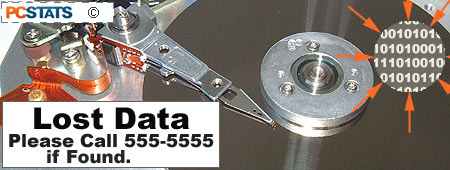
|
Hard drives, being the dynamic storage
devices that they are, are extremely easy to erase in any number of amusing and simple to achieve ways. This Guide also deals with recovering deleted formatted information. UPDATED - How to fix a 1TB hard drive that suddenly changes to 0.0GB, or 32MB in size.
|
|
|
|
Home >
Reviews >
Beginners Guides >
PCSTATS |
|
|
Beginners Guides: Hard Drive Data Recovery
Killed a hard drive without
backing up? Deleted your babies first photo and already emptied the recycling
bin? Not to worry, you can probably recover your data with the help of this guide from PCSTATS. - Version 3.6.3
If you've
been using computers for a decent amount of time there is a
good chance someone has told you that data stored on a hard drive
is not exactly safe. I'm here to assure you that this is indeed true.
Never mind the fact that unlike tapes or CDs or other methods of storage, hard drives are mechanical, active devices and are thus subject to comparatively
rapid breakdown.
No, the real threat to hard drives are the people that
use them, by which I mean you and me. Hard drives, being the dynamic storage
devices that they are, are extremely easy to erase in any number of amusing and simple to achieve ways... as are USB hard drives and flash memory cards (recovery tips for that media is detailed here). Also recently added; How to fix a 1TB hard drive that suddenly changes to 0.0GB, or 32MB in size.
Working as a computer tech during the glory days of
Windows XP, you get rather used to using FDISK and other hard drive utilities to
prepare and repair customer's drives, which leads to a certain over confidence.
That attitude can lead straight to disaster, sort of like giving a 12
year old boy the keys to an ATV.
Picture this if you will; there I was, two or three sentences and a screen shot away
from finishing a 5000+ word article on computer upgrades. All I had to do was fire
up FDISK on a dual boot Windows PC system and grab a few screen shots.  I figured I'd write a little blurb
on how to partition a drive, making sure to tell the readers not to mess with
FDISK if they were not sure what they were doing… I figured I'd write a little blurb
on how to partition a drive, making sure to tell the readers not to mess with
FDISK if they were not sure what they were doing…
Yes, there's
going to be some irony here.
So anyway, I wanted to get some more
screen shots of the actual partitioning screen, but I did not have a blank hard
drive handy. I figured I could use my NTFS formatted XP drive (which
FDISK perceived as a blank drive) to start the "process," grab the screen shots
and then cancel the partitioning.
No problem. Except for one little thing…
I had forgotten that FDISK, in the process of
checking the disk before it prompts you for the size of the partition,
writes information to certain areas of the hard drive. This data writes
over whatever might have been there before. Meanwhile, there I was, watching the '%complete' counter
and wondering why a little red warning flag kept going off in my brain?
I restarted WinXP and waited for it to boot, and
waited... and waited... Oops.
|
|
© 2025 PCSTATS.com
Please respect the time and effort that went into creating each PCSTATS Beginners Guide, do not illegally copy. Thank you.
|
Next Page >
|
|

